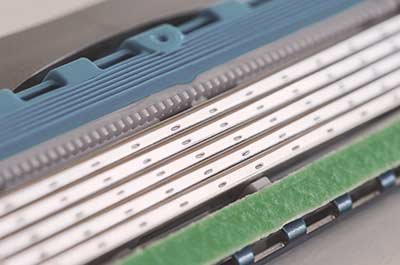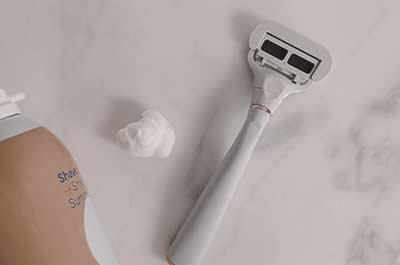Removing hair from your body is a personal preference. Some men prefer to keep themselves well-groomed, while others may feel that the extra effort is unnecessary.
Regardless of what you choose to do with your body hair, it’s essential to know how to remove it without causing severe skin irritation or injury.
We’ve compiled this list of FAQs about removing male body hair or manscaping and asked the experts, so you can make an informed choice on whether or not this process suits your needs and preferences.
What are the different methods of body-hair removal for men?

There are many different hair removal methods for men, but the most common ones include shaving, waxing, and using a depilatory cream.
Shaving is probably the most popular method because it’s relatively quick and easy to do. However, it can cause skin irritation and leave a nasty stubble look.
Waxing is an excellent choice for men who want to remove hair from their body because it’s quick, doesn’t require much effort on their part, and has longer-lasting results than shaving does. However, waxing can be painful in some areas of the body with more nerve endings, so consider this when choosing which method you prefer.
Depilatory creams work by dissolving down the fatty acids in hair follicles and causing them to loosen up without damaging skin tissue or killing off cells like laser removal methods do—this means that depilatory cream works quickly but causes less long-term damage than these other methods. Depilatory creams can be a little harsh on the skin, so make sure to do a patch test before using one in an area where you have sensitive skin.
There are also several other methods of hair removal that you may want to consider, such as:
Electrolysis: This is a process where individual hairs are removed from the body using a tiny electrical current. It’s considered a more permanent solution than other methods, but it can be expensive and time-consuming.
Laser hair removal: This method uses light beams to target and destroys hair follicles. It’s considered a more permanent solution than electrolysis, but it can also be expensive and may not be suitable for everyone.
Threading: This is an ancient Indian hair removal method that uses a thin thread to remove hair from the face. It’s considered less painful than waxing and can be done at home with some practice.
Each man will have his own preferences for body-hair removal, so it’s important to experiment with different methods until you find one that works best for you.
What are some of the common side effects expected when removing body hair?
Some common side effects can be expected when it comes to body hair removal for men. While most people experience little discomfort after their initial waxing session or using an epilator, individuals with sensitive skin may feel a stinging sensation in the area where hair was removed when water is applied immediately afterward.
To decrease pain associated with removing body hair in this way, experts recommend waiting at least 20 minutes before showering to give your skin time to cool down slightly so you don’t burn yourself when exposing wet skin to hot water too quickly.
Another possible side effect of removing body hair is ingrown hairs due to improper shaving techniques being used beforehand or if the follicle has been damaged during treatment procedures. Treating ingrown hairs can be done at home using over-the-counter products such as Tend Skin, but if they become severe or don’t clear up within a few days, then it’s best to see your dermatologist.
After body grooming, some men experience redness, irritation, or ingrown hair.
Redness and irritation can be caused by many factors, including shaving too close to the skin, having sensitive skin that’s prone to breakouts, or using harsh depilatory creams on your face or chest that cause inflammation in the area where you used it.
In most cases, this will resolve itself over time as long as you’re gentle with your skin and give it adequate time for rest from hair removal.
In some cases, men may experience ingrown hairs around areas like their neckline or back if they frequently shave without giving themselves enough recovery time between each use—this is especially true when dealing with thick, coarse facial hair growth patterns because these are more likely to curl back into the skin and cause irritation.
Suppose you’re experiencing any of these side effects. In that case, it’s important to discontinue the hair removal method that’s causing them and find a different one that doesn’t result in skin irritation. You should also consult with a dermatologist if the irritation persists and is causing you discomfort.
Sometimes, you will need to apply a cream to the irritated area. Aloe vera is a good choice because it has anti-inflammatory properties that can help soothe your skin.
How often should I shave my body hair to keep it looking good and feeling smooth?
This will depend on the type of hair, how fast it grows back, and your personal preferences.
Some people find that shaving once every two weeks gives them the best results, while others prefer to shave once a month or even less often.
Experiment until you find what works best for you—just be sure to avoid shaving too close to the skin, as this can cause razor burn and irritation.
What are some common mistakes men make when removing their body hair?
The following are some of the most common mistakes men make when removing their body hair:
- Shaving too close to the skin, which can cause razor burn and irritation.
- Using the wrong shaving technique for your body hair or skin type.
- Not allowing adequate time between shaves to let their skin recover from irritation or damage caused during previous sessions of removing their body hair.
- Not using shaving cream or gel, which can make the razor drag across your skin and cause cuts.
- Shaving in the wrong direction (against the grain of the hair), which can result in ingrown hairs.
- Leaving stubble behind, which can make your body hair look thicker and more noticeable.
- Using an old blade, which can increase your chances of getting nicks and cuts.
- Using harsh or abrasive depilatory creams, which can damage the follicle and cause ingrown hairs.
- Not waiting long enough between treatments, which can cause the follicle to become damaged and prevent hair regrowth.
- Overdoing it when shaving with a razor, which can irritate your skin or damage the follicle if done too frequently.
To avoid these mistakes, it’s essential to take your time when shaving, use a good quality shaving cream or gel, shave in the right direction (with the grain of the hair), and replace your blades often. If you’re still experiencing problems after following these tips, consult with a professional to get advice on best removing your body hair.
What are tips on how to reduce irritation after shaving or waxing?
Some tips on how to reduce irritation after shaving or waxing are:
- Shave in the direction of hair growth.
- Apply a good moisturizer to the skin after shaving. Use soothing products on irritated areas of the skin like body lotions containing cocoa butter and oatmeal extracts or aloe Aloe Vera.
- Wax every two weeks or less frequently if possible because waxing can irritate your skin more than other hair removal methods.
- Avoid stretching the skin while shaving.
- Apply a cold compress or rinse the area with cold water after shaving or waxing. This will help close the pores and reduce irritation.
- Avoid scratching or rubbing the area, which can further irritate the skin.
What are some of the benefits of removing body hair for men?
Some of the benefits of removing body hair for men are:
Improved hygiene. Men who remove their body hair can prevent dirt and bacteria in their hair follicles.
Greater comfort. Body hair can be itchy and irritating, especially if it grows back quickly. Men who remove their body hair can enjoy a more comfortable experience while wearing clothes and during hot weather.
A smooth look and feel. Body hair can make your skin appear unappealing to the eye, which is why many men choose to remove it. Removing body hair can make you look sharper and more polished.
A more youthful appearance. Removing body hair can make you look younger and help to accentuate your features.
Improved self-confidence. When you feel good about how you look, it shows in your attitude and demeanor. Men who remove their body hair often feel more confident and self-assured.
When should men avoid removing their body hair?
Men should not remove their body hair when:
- They have skin conditions like eczema, psoriasis, or acne, which can become irritated and inflamed by shaving. Some people with these conditions find it’s best to leave the area alone entirely for the condition to heal properly.
- They have ingrown hairs, which can be painful and unsightly. Ingrown hairs can be caused by several factors, including improper shaving techniques and the use of depilatory creams. If you have a lot of ingrown hairs or your skin is susceptible to irritation, it’s best not to remove body hair entirely until the condition has been treated.
- They have exposed cuts, scrapes, rashes, boils, warts, sores, and sunburns on their skin. Shaving or waxing can make these conditions worse because they are irritated easily. Instead of removing these irritations through hair removal techniques that will only make them worse, you should consult with a healthcare professional to determine the best course of action.
- They will be in a situation where they need to be physically active. Body hair can help protect your skin from friction and chafing, so it’s best to leave it on if you’re working out or playing sports.
- Their body is covered in tattoos. Shaving over tattooed areas can cause the ink to fade or become distorted.
- They have just undergone laser hair removal treatments. Wait at least two weeks after your last treatment before removing any additional body hair.
- They are undergoing treatment for a medical condition like cancer or taking medication that causes thinning of the skin. Shaving can cause cuts and nicks, which allows bacteria to enter through your pores, so it’s essential to wait until after treatment is over before shaving again.
- They’re experiencing a rare side effect of waxing called folliculitis. Folliculitis is an infection caused by bacteria that can occur in the hair follicles after removing body hair and result in red bumps or skin discoloration on the area where you removed your body hair. If this happens, stop shaving until it heals completely to prevent further irritation during treatment sessions.
- Their follicles are aggravated by recently waxing or tweezing hairs out of them because this could cause a breakout on the face if done too close to the root.
- The weather is extremely cold outside, which could lead to chapped skin that increases your chances of getting nicks and cuts while shaving away.
- They will be in the sun for an extended period, increasing their chances of getting sunburn.
Is there any way to make this process less painful?
There are a few ways that you can make hair removal less painful or expensive:
- Use a good quality shaving cream or gel. Cheap shaving cream can dry out your skin and irritate it, increasing the chances of nicks or razor burns.
- Use a new, sharp blade. Dull blades cause more irritation by pulling at hairs instead of cutting them cleanly, resulting in red bumps on the area you removed body hair from. Avoid using a double-edge razor because the blades are often too sharp and can cause more nicks and cuts.
- Shave in the direction of hair growth to minimize irritation.
- Shave in the shower when your skin is most pliable, and avoid going over an area more than once to prevent irritation.
- Use a gentle cleanser after you shave, which will help to clear away any dead skin cells that can clog follicles, causing ingrown hairs.
- Apply a cold compress to the area after shaving to help soothe any irritation or redness.
- If you’re using waxing as your hair removal method, ensure that the wax is not too hot and wait until the skin has cooled completely before applying it.
- Prevent folliculitis by gently exfoliating the skin before you wax or tweeze and avoid going over the same area more than once. Avoid exfoliating for at least 24 hours before removing body hair.
- If you’re using a depilatory cream, ensure that it’s not expired or too old. If you’re using a depilatory cream, make sure that there is at least an inch of hair on the surface of your skin before applying it.
- Apply a moisturizer to the area after removing body hair to help soothe any irritation or redness.
Is it true that shaving makes the hairs grow back thicker and stronger than they were before being shaved off?

This is a common misconception that has been debunked by science. Shaving does not make the hairs grow back thicker or stronger than before being shaved off – it just seems that way because when you shave, the hair is cut off at the surface of the skin rather than at the root. This can cause the hair to appear coarser and darker because it’s now cut straight across instead of tapered at the end.
The way hairs look when they emerge from the skin after being removed depends on how thickly you were covered in them and what part of their growth cycle (anagen, catagen, telogen).
Hairs will always be at different stages of growth which can contribute to some looking thicker than others, even if you shave regularly.
Your hair removal method also affects how quickly the hair grows back, as waxing removes more than just the surface layer of cells, so this slows down regrowth compared to shaving with a razor blade.
How should I prepare my skin before removing unwanted hair from my body?
It’s essential to prepare your skin before removing body hair to avoid any irritation or injuries. Preparation is key to making hair removal less painful and more effective.
Ensure that you exfoliate before removing body hair, which will help remove the topmost layers of dead skin cells and unclog follicles so hairs can be removed easily without irritation or ingrown hairs. Avoid exfoliating for at least 24 hours before removing body hair.
Avoid using harsh scrubs on your face as this could cause micro-tears on the surface of your skin through which bacteria could enter, leading to infection.
Body Lotion.
Next, use a body lotion on the areas you plan to body groom, making the hairs stand up and become much easier to remove. Make sure the area is clean and dry using a gentle cleanser, especially if you are planning on shaving with a blade because this will help prevent nicks and cuts from occurring.
Use a good quality shaving cream or gel. Cheap shaving cream can dry out your skin and irritate it, increasing the chances of nicks or razor burns.
Waxing at home.
If you’re waxing at home, ensure that all moisturizers have been removed entirely (use soap for this) before applying hot wax to ensure it sticks properly without sliding off easily, like butter melting in the sun! If there are still traces of lotion left on the skin, it will act as a barrier to the wax and make the hair removal process much more difficult.
Avoid water.
You should avoid taking a shower or bathing right before removing body hair because this can soften the hair and make them more challenging to remove.
Avoiding hot water will also help prevent irritation when shaving, so take showers instead of baths for this purpose.
If you’re using shaving as your method of depilation, wait until at least three hours after applying lotions, perfumes, colognes, or deodorants because these items may irritate your skin if they come into contact with it while wet.
Conclusion.
There are many benefits to manscaping (removing body hair from your arms, legs, chest, back, shoulders, and other parts of your body).
Removing body hair can help you look and feel better about yourself, important to your mental health. With the proper preparation, it’s possible to remove unwanted hair without experiencing any pain or discomfort.
We hope that this article has answered some of your questions about hair removal and that you feel more confident in removing hair from your own body.
Thanks for reading!

Lenny Terra is the founder & editor-in-chief. He’s a life coach, software engineer, freelance writer, and has a diploma in Modern Applied Psychology. Lenny has a passion for great living & beautiful design. He is married and is the father of two beautiful girls. His life’s mission is to help people improve their lives, become happier and more productive. This blog is his contribution to that goal and to the empowerment of his readers. Lenny and his family live in Texas with their two dogs.